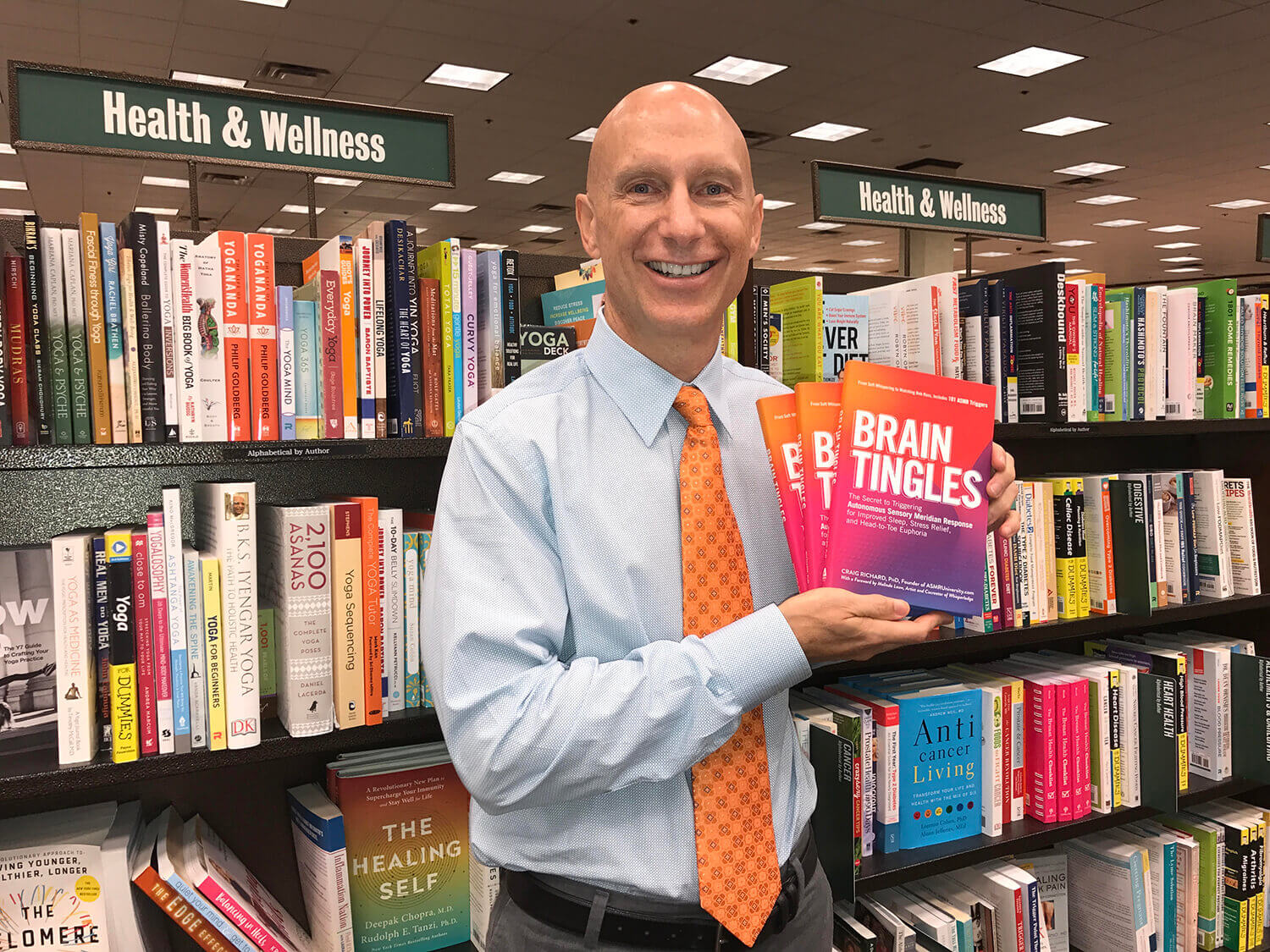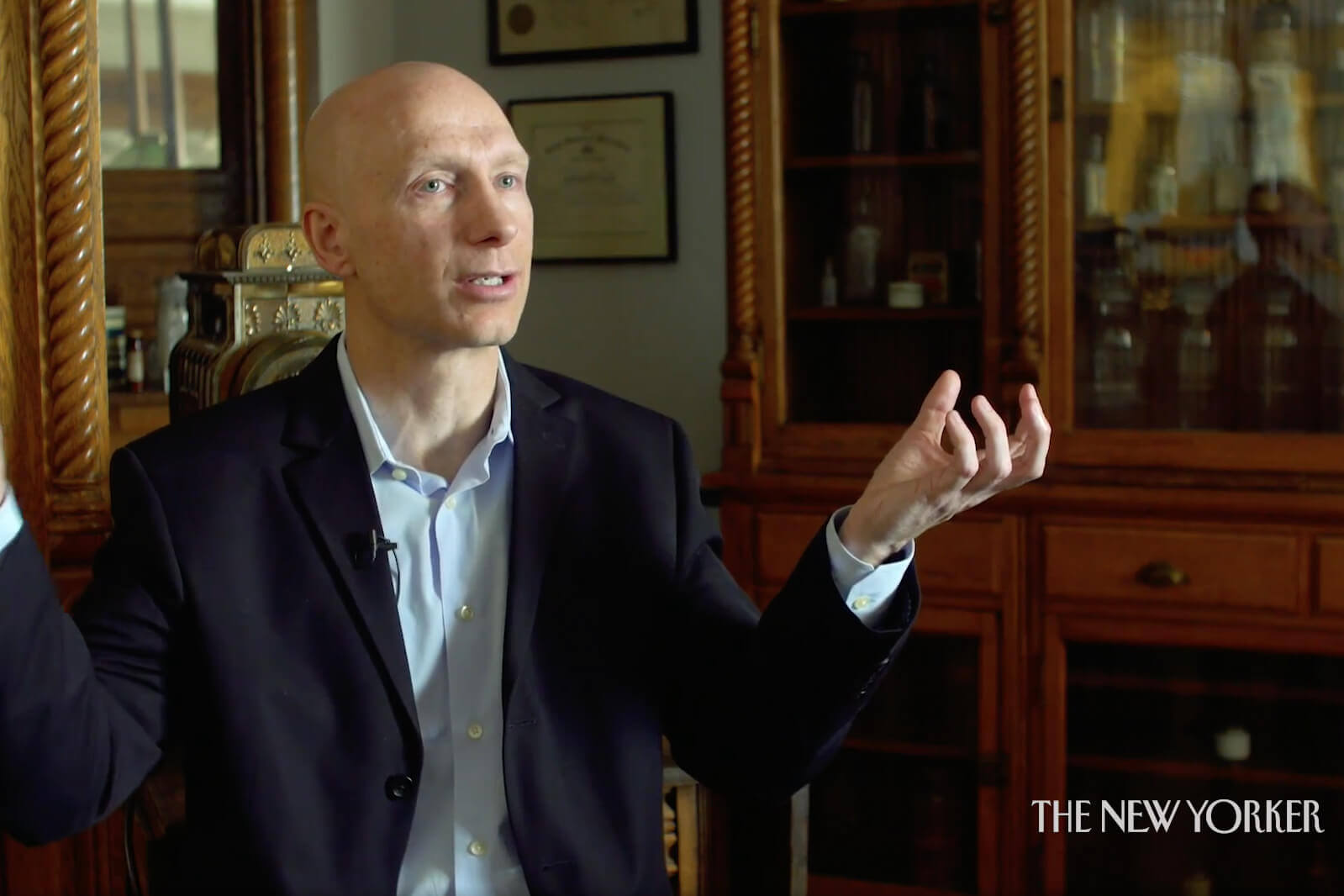Have you seen videos where people whisper, cut hair, or unwrap candy bars slowly to help other people relax? If you have, you’ve potentially experienced Autonomous Sensory Meridian Response, or ASMR, and Shenandoah University Professor of Biopharmaceutical Sciences Craig A. H. Richard, Ph.D., has become an expert in the field, through both his research and as founder of the ASMR University website.
In recent years, Dr. Richard and ASMR University have been featured in reports by major television networks (most recently on NBC’s “Today” show), Newsweek, The New York Times, The New Yorker, The Washington Post, Scientific American, Buzzfeed, Smithsonian Magazine, Women’s Health, Mashable and an NBC mini-documentary. If you want to know about ASMR, he’s the go-to guy. And on Tuesday, Sept. 4, his book about ASMR, “Brain Tingles: The Secret to Triggering Autonomous Sensory Meridian Response for Improved Sleep, Stress Relief, and Head-to-Toe Euphoria,” was published. He also podcasts via ASMR University (as Dr. Richard) and Sleep Whispers (as “Harris.”)

We caught up with Richard for a few minutes to talk about his research, how it connects with his life as a pharmacy professor (he’s been with Shenandoah for 15 years), and more.
Q: What is ASMR?
CR: ASMR stands for Autonomous Sensory Meridian Response. It is a deeply relaxing feeling usually accompanied with pleasurable brain tingles. It is commonly triggered by one person providing another person with caring personal attention. Typical interactions can involve hairdressers, clinicians, teachers, friends, and parents. Individuals on YouTube simulate these personal moments in videos and then viewers watch them for relaxation and help falling asleep.
Q: What first piqued your interest in it?
CR: In 2013, I was listening to a podcast and learned about ASMR for the first time. The episode explained that anyone who is deeply relaxed by haircuts or by watching Bob Ross’s TV show, “The Joy of Painting,” probably experiences ASMR. Getting haircuts and watching Bob Ross always made my brain go fuzzy and put me into a deep tranquil state; so that was the day I found out I experienced ASMR. (Richard’s ASMR triggers.)
Q: Why were you inspired to create ASMR University online?
CR: After I found out I experienced ASMR in 2013, I immediately went looking for published research on it to learn more about it. I soon found out there wasn’t any published research on ASMR, and I also couldn’t find good explanations for the potential biology behind ASMR. So in 2014, I founded ASMRUniversity.com to launch a research study, post hypotheses about ASMR, encourage others to do research, and share research done by others.
Q: What sort of research are you doing into ASMR at the moment?
CR: I’m working with Karissa Burnett and Jennifer Allen on an online survey about ASMR. So far, we have over 26,000 participants from over 110 countries. The survey is helping us to understand some very basic aspects about the triggers and sensations involved with ASMR. (Survey research: https://asmruniversity.com/asmr-survey.) I’m also working with additional researchers to publish a fMRI study on the brain regions activated during ASMR.
Q: Why do you think ASMR’s “time has come,” particularly on YouTube, and why is it growing in popularity?
CR: The most important factor for the rise of ASMR videos is that they effectively help a significant amount of people to feel more relaxed, less stressed, and to fall asleep more easily. The other factors that fuel the popularity of ASMR videos is that they are free and easily accessible – so deep relaxation is only a click away for anyone with internet access. Even celebrities like Kate Hudson, Jake Gyllenhaal, Gal Gadot, and Jeff Goldblum have created videos intended to stimulate ASMR. The rise of ASMR is further reflected in and fueled by ASMR-inspired commercials, books, movies, music, comedy and more. (ASMR and celebrities – https://asmruniversity.com/art-of-asmr-celebrities – and the rise and history of ASMR – https://asmruniversity.com/history-of-asmr.)
Q: You’ve had a firsthand view of the rise of ASMR, being quoted in a plethora of online and video reports about it. What does it feel like to be a go-to expert in this growing field?
CR: I think it’s difficult for journalists to report on any “phenomenon” because the interest can quickly outpace the understanding – and ASMR is no exception. It seems that my website provides a single place for journalists, reporters, researchers, and anyone else trying to learn about ASMR, to easily access the history, research, science, art, and pop cultural expressions of ASMR. (Media agencies that have sourced the website: https://asmruniversity.com/asmr-university-media-contact/)
Q: Why did you decide to write a book about ASMR? What was the process of writing it like, and how long did it take to complete?
CR: There is not a guide out there for how to stimulate ASMR. The intent of the book therefore is to encourage and teach people how to stimulate person-to-person ASMR. This can be helpful for lulling a child to sleep, soothing a stressed family member, relaxing a friend or romantic partner, creating ASMR videos, or incorporating proper ASMR techniques into spas, health studios, wellness centers, counseling sessions, and clinical research studies.
Creating the content in my website over the past few years prepared me well for the principles and techniques in the book. The bigger challenge was the process of putting that information into clear and logical sentences, paragraphs, and chapters. This was my first book, it took me about six months to write it and I definitely learned that crafting eloquent prose is not one of my natural talents.
Q: What are those “brain tingles” that inspired the book’s title? What’s happening to your body as ASMR occurs? What can ASMR be used for?
CR: No one really knows yet what is triggering those brain tingles. The fact they are pleasurable though is a big hint and supports a role for endorphins. Endorphins are released in the brain to buffer pain or induce pleasure. It is likely, though, that there is a cocktail of brain chemicals involved in ASMR. Oxytocin is likely involved because it is associated strongly with bonding and grooming behaviors; these behaviors are similar to those which stimulate ASMR. Dopamine may drive some of the desire for seeking ASMR triggers and fuel the maintained focus that frequently happens when people are watching these seemingly boring videos for long periods of time. According to our research and research by others, most people seek out ASMR because it helps them to relax, de-stress, and fall asleep. Other reported benefits include a positive effect on mood, increased focus while studying or working, and decreased chronic pain.
(More info about biology of ASMR – https://asmruniversity.com/origin-theory-of-asmr/ and data and info on benefits of ASMR – https://asmruniversity.com/health-benefits-of-asmr/)
Q: What kinds of tips do you offer in the book?
CR: Being able to have the best ASMR experience is similar to being able to have the best dining experience. Every detail is important and overlooking something small can impede the enjoyment. So the book gives tips for selecting a partner, a location, a time of day, and even how often to experience ASMR. Tips also include how to create ideal triggers through whispering, light touch, creating sounds with objects, demonstrating a task, and giving personal attention. Worksheets are included in the book so ASMR sessions can be structured and enjoyed just like a five-course meal.
Q: How does your ASMR research connect with your life as a pharmacy professor?
CR: Stress, sleeplessness and low mood can either be the primary disorder for patients visiting pharmacies, or can be a result from their primary disorders. The research done by myself and others is supporting that ASMR may have benefits for these health challenges. Conditions like anxiety, insomnia, and depression can be well managed with medications, but medication may also be part of a larger treatment plan. Medications can be combined with non-pharmacological therapies like cognitive behavioral therapy or evidence-based relaxation techniques, as well as lifestyle changes, to improve outcomes. Some patients are resistant to taking medications, don’t respond well to medications, or may have side effects or adverse events that create additional problems. Researching ASMR is therefore important to determine if the incorporation of ASMR into a patient’s treatment plan could be beneficial. There is still a lot of research to be done before the effectiveness of ASMR can be better understood and potentially incorporated into evidence-based healthcare.
Q: How do you hope to see ASMR research grow?
CR: ASMR research is just beginning. There are only seven peer-reviewed research publications about ASMR, and most of those involve self-reported information through online surveys. Those surveys, mine included, are just a starting point, but do provide a helpful foundation and guidance for more studies. The first physiological study on ASMR was just published and demonstrated that the decrease in heart rate during ASMR is equal to the decreased heart rate observed in clinical trials involving music-based stress reduction for cardiovascular diseases. The study also showed that ASMR stimulated a greater decrease in heart rate than mindfulness interventions that are used to reduce anxiety. There needs to be many more physiological studies, along with well-controlled clinical studies, to determine if ASMR has something significant to add to current evidence-based treatments. (List of published research articles on ASMR: https://asmruniversity.com/asmr-research-and-publications/)




